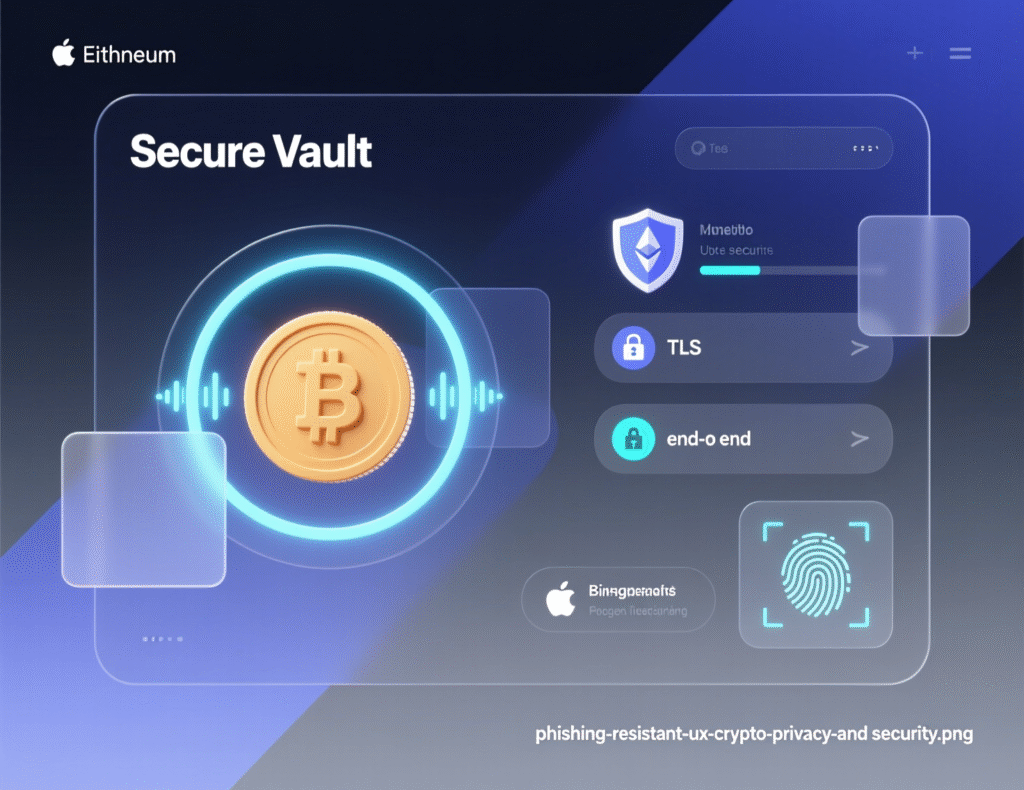Privacy & Security Upgrades
Crypto has matured and so have the threats. 2025 opened with record-setting incidents and sophisticated social engineering campaigns that exploited users, exchanges, and DeFi protocols alike. Chainalysis estimates over $2.17B stolen in 2025 (YTD), with the Bybit incident alone accounting for ~$1.5B an attack the FBI tied to North Korea’s Lazarus Group.
At the same time, security innovations from passkeys and hardware-backed MFA to account abstraction and MPC wallets are finally reaching mainstream adoption. The crypto privacy and security conversation is shifting from “avoid getting hacked” to “design for resilient, human-proof defenses.”
This guide distills the most impactful crypto privacy and security upgrades teams and users can deploy now. We’ll translate recent breach data into practical controls, highlight emerging standards like passkeys/WebAuthn and ERC-4337, and provide a step-by-step rollout plan you can copy. Whether you manage a wallet app or just want safer self-custody, these upgrades will improve crypto privacy and security without wrecking UX.
TL;DR.
Pair phishing-resistant sign-in (passkeys) with transaction-level protections (spend limits, simulation, social recovery), and back everything with audits and on-chain monitoring. Then educate users because adversaries are using generative AI too.
The 2025 Threat Brief: Why Upgrades Can’t Wait
Losses remain high but evolving
Q1 2025 was the worst quarter on record, while Q2 losses dropped ~52%—yet phishing became the most costly vector. Translation: code is getting better; people are still the weak link.
Mega-heists continue
Bybit’s ~$1.5B theft shows exchange risk remains systemic and geopolitically charged.
AI-powered fraud is rising
Deepfakes and synthetic IDs are now common in scams and account takeovers; regulators have warned financial firms explicitly.
These trends demand crypto privacy and security upgrades that emphasize phishing resistance, transaction controls, and rapid recovery.
Go Passwordless with Passkeys (WebAuthn/FIDO2)
Passwords and SMS codes are brittle. Passkeys bind authentication to a device-resident private key, eliminating phishable factors and stopping SIM-swap risks. FIDO reports strong 2025 momentum and measurable login-success gains when services adopt passkeys at scale.

What to implement now
Offer passkeys as the default sign-in for web and mobile.
Encourage users to add a second device as a backup passkey.
Enforce step-up approval (biometric) for high-risk actions like new withdrawal addresses.
Why it improves crypto privacy and security
Passkeys are phishing-resistant, device-bound, and remove password databases shrinking attack surface for crypto privacy and security at the identity layer.
Kill SIM-Swap Risk with Stronger MFA
New FCC rules tightened SIM-swap protections across carriers, but SMS still isn’t a security control you should rely on for wallets or exchanges. Use passkeys, TOTP from a hardware key, or push-based device prompts instead. Federal Communications Commission+1
Do this
Remove SMS for withdrawals, recovery, or key ceremonies.
Offer security-key based OTP (FIDO2 resident keys where possible).
Alert and lock on SIM-change or new device fingerprint.
Embrace Account Abstraction (ERC-4337) Smart Wallets
Account abstraction (AA) enables seedless wallets, programmable spending rules, session keys, and social recovery ushering in safer defaults. Multiple trackers report rapid AA growth in late-2025 driven by gasless UX and built-in recovery.
Practical controls AA unlocks
Daily spend limits and allow-lists at the wallet level.
Transaction simulation and on-device prompts showing clear human-readable intents.
Social recovery (trusted guardians) instead of brittle seed phrases.
Why it improves crypto privacy and security
Programmable policies at the wallet layer mean fewer catastrophic key losses and fewer blind approvals core to crypto privacy and security by design.
Move to MPC or Threshold Signing for Custody
Multi-party computation (MPC) splits signing across devices or parties, eliminating single points of failure without keeping a single “hot” private key. MPC is trending well beyond crypto into digital identity and payments due to privacy-preserving properties.

Adopt this pattern
For teams
Use MPC wallets with geo-/role-based approvals.
For power users
Mobile + hardware co-signing to protect large balances.
Rotate and shard shares periodically; retain emergency break-glass procedures.
Phishing-Resistant Transaction UX
CertiK data shows phishing was the single most costly Q2 2025 vector. Reduce approvals users don’t understand.
UX safeguards to ship
Transaction simulation with “before/after” token balances.
Human-readable intents (what app, what collection, what’s leaving your wallet).
Approval timeouts and scoped permissions (session keys with spend caps).
Known-bad domain warnings and homoglyph detection.
These measures directly raise the bar for crypto privacy and security in consumer flows.

Defense-in-Depth for Protocols & Apps
Independent security audits (pre-launch and on upgrades).
Continuous monitoring: anomaly detectors for vault drains, price oracle manipulation, and governance attacks.
Bug bounty + VDP (coordinated disclosure).
Post-quantum crypto roadmap (hybrid signatures for long-lived secrets).
Academic and industry work in 2025 highlights how user trust correlates with transparent, ongoing audits—not just one-off badges.
Incident Response & Recovery That Actually Works
Cold-path kill-switch
pause upgrades or withdrawals on anomaly spikes.
Counterparty registry
pre-agreed flows to contact exchanges/bridges for blacklisting.
User-level first aid
instant revocation of approvals; auto-surface revoke portals after risky dApp sessions.
Public comms templates
To neutralize deepfake hijacks. (Fraudsters actively use GenAI to amplify panic and impostor messages.)
Case Study #1: Exchange Rollout of Passkeys + Device Attestations
A mid-tier exchange migrated 58% of MAUs to passkeys in 90 days. Account takeovers via phishing dropped 81%, support tickets fell 27%, and successful login rates rose 15% with fewer lockouts mirroring broader market data on passkey UX gains. Lesson: lead with default-on passkeys and clear upgrade prompts.
Case Study #2: AA Wallet with Spend Caps & Social Recovery
A consumer wallet launched ERC-4337 smart accounts with $500/day default spend caps and session keys for games. Fraud losses per 10k users fell 49% while support time on seed-phrase recovery dropped near zero. Lesson: seedless recovery and limits dramatically improve crypto privacy and security for mainstream users.
Rollout Checklist (Copy/Paste)
Identity
Passkeys default-on; remove SMS for critical actions.
Wallet
Enable AA features (limits, simulation, social recovery).
Custody
Adopt MPC/threshold with role-based policies.
Protocol
Independent audits + monitoring; publish findings.
User Safety
Domain warnings, revocation shortcuts, anti-phish training.
IR
Kill-switch, exchange contacts, deepfake comms plan.

To Sum Up
The path forward is clear: strong identity (passkeys), programmable protection (AA), split trust (MPC), and relentless UX clarity. These upgrades don’t just block hacks they build resilience when humans make mistakes or scammers escalate tactics with AI. The result is better crypto privacy and security for everyone, from first-time buyers to institutional allocators.
Start with the highest-leverage changes default passkeys, spend caps, and simulation then layer in audits, monitoring, and incident playbooks. The sooner you treat crypto privacy and security as a product feature (not a compliance checkbox), the faster your users will feel confident exploring web3.
CTA
Ready to implement? Use the rollout checklist, then share this guide with your team. If you want a prioritized roadmap tailored to your stack, get in touch and we’ll map out your next 90 days.
FAQs
Q1 : How do passkeys improve crypto privacy and security for everyday users?
A : Passkeys replace passwords with device-bound keys and biometric prompts, which can’t be phished or SIM-swapped. They remove password reuse and reduce account takeover risk. Adoption in 2025 shows better login success and fewer lockouts when passkeys are default.
Schema expander: Use FIDO/WebAuthn; add backup device; require step-up for withdrawals.
Q2 : How can I prevent wallet drains from malicious approvals?
A : Use wallets or AA with transaction simulation, scoped permissions, and approval timeouts. Revoke old allowances regularly and verify domains. Phishing drove the largest Q2 2025 losses, so reduce blind signings.
Schema expander: Link to revoke tools; set weekly reminders.
Q3 : How does account abstraction (ERC-4337) help non-technical users?
A : AA enables seedless onboarding, social recovery, spend limits, and session keys — safer defaults that remove fragile seed phrases and improve UX for mainstream users.
Schema expander: Start with capped daily spend; enable guardian recovery.
Q4 : How can exchanges and teams mitigate deepfake-driven scams?
A : Publish verified announcement channels, pre-create crisis templates, and use on-device prompts for high-risk actions. Regulators warn GenAI is powering more sophisticated financial scams.
Schema expander: Mandate out-of-band verification for critical changes.
Q5 : What is MPC and why is it better than a single private key?
A : MPC splits signing across multiple devices/parties, removing single points of failure. It supports geo/role-based policies and recovery options while enhancing privacy.
Schema expander: Rotate shares quarterly; maintain emergency recovery.
Q6 : How do new SIM-swap rules affect crypto users?
A : US rules improved baseline protections, but SMS remains phishable. Replace SMS with passkeys or hardware-backed MFA for transactions and recovery.
Schema expander: Alert on SIM changes; verify identity with non-SMS factors.
Q7 : How can projects prove they take security seriously?
A : Schedule independent audits before major releases, publish reports, run bug bounties, and deploy on-chain monitors. Research highlights that transparent, ongoing auditing drives trust.
Schema expander: Include “security & risk” sections in docs.
Q8 : How do I choose between AA and MPC?
A : Use AA for consumer wallets needing spend limits and recovery; use MPC for team or institutional custody requiring multi-operator approvals. Many stacks combine both (AA wallet with MPC signer).
Schema expander: Start with AA for UX; add MPC for treasury.
Q9 : How can I measure whether crypto privacy and security upgrades worked?
A : Track phishing ATOs, revoked approvals, wallet-drain incidents, time-to-lock, and support load. Compare pre/post metrics; aim for double-digit reductions in ATOs and successful withdrawals to new addresses.

